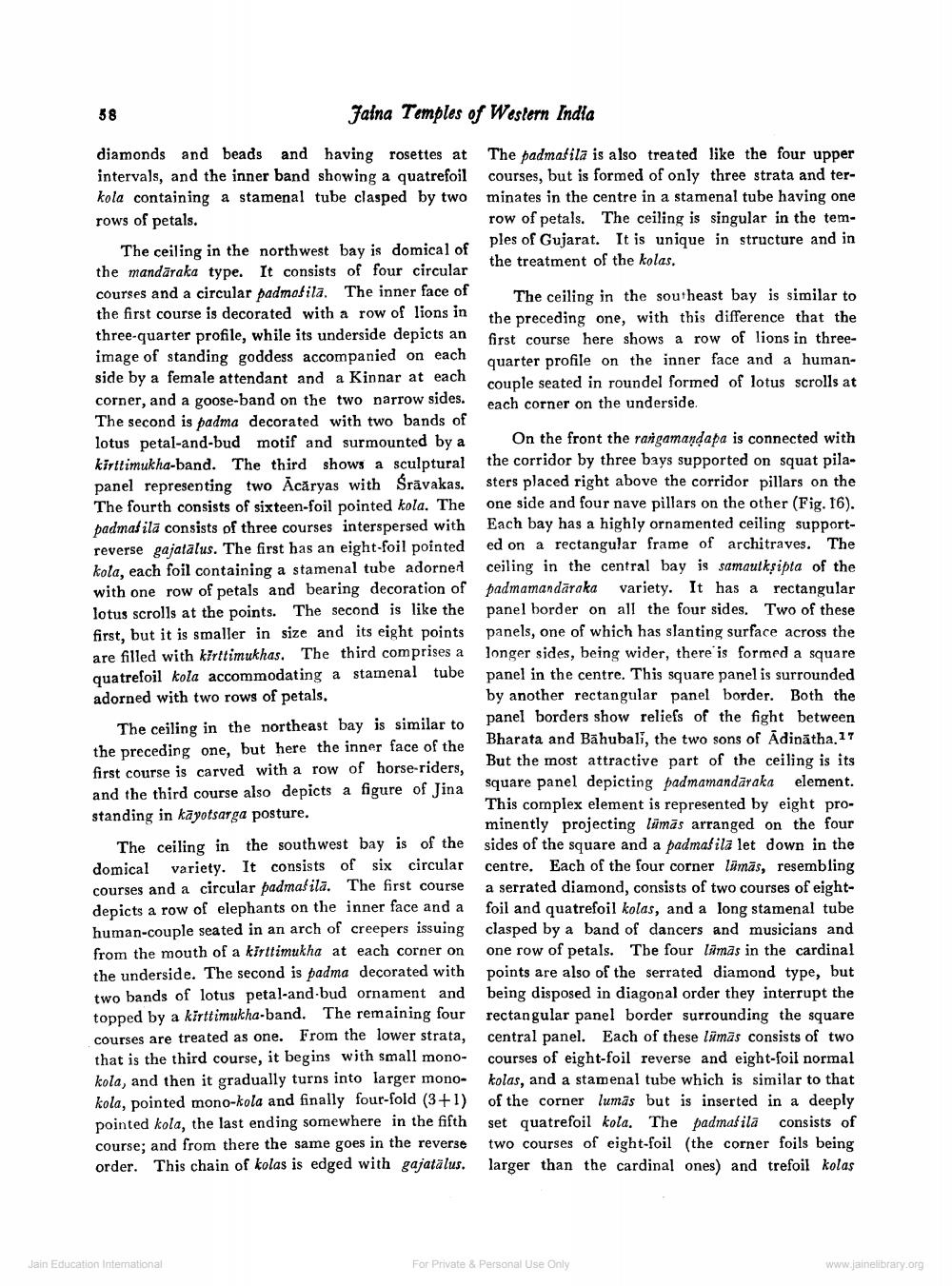________________
58
Jalna Temples of Western India
diamonds and beads and having rosettes at The padmašila is also treated like the four upper intervals, and the inner band showing a quatrefoil courses, but is formed of only three strata and terkola containing a stamenal tube clasped by two minates in the centre in a stamenal tube having one rows of petals.
row of petals. The ceiling is singular in the temThe ceiling in the northwest bay is domical of
ples of Gujarat. It is unique in structure and in the mandāraka type. It consists of four circular
the treatment of the kolas, courses and a circular padmašila. The inner face of The ceiling in the southeast bay is similar to the first course is decorated with a row of lions in the preceding one, with this difference that the three-quarter profile, while its underside depicts an first course here shows a row of lions in th image of standing goddess accompanied on each
quarter profile on the inner face and a humanside by a female attendant and a Kinnar at each
couple seated in roundel formed of lotus scrolls at corner, and a goose-band on the two narrow sides. each corner on the underside. The second is padma decorated with two bands of lotus petal-and-bud motif and surmounted by a
On the front the rangamandaba is connected with kirttimukha-band. The third shows a sculptural the corridor by three bays supported on squat pilapanel representing two Ācāryas with Srävakas. sters placed right above the corridor pillars on the The fourth consists of sixteen-foil pointed kola. The one side and four nave pillars on the other (Fig. 16). padmašila consists of three courses interspersed with Each bay has a highly ornamented ceiling supportreverse gajatalus. The first has an eight-foil pointed ed on a rectangular frame of architraves. The kola, each foil containing a stamenal tube adorner ceiling in the central bay is samautksipta of the with one row of petals and bearing decoration of padmamandāraka variety. It has a rectangular lotus scrolls at the points. The second is like the panel border on all the four sides. Two of these first, but it is smaller in size and its eight points panels, one of which has slanting surface across the are filled with kirttimukhas. The third comprises a longer sides, being wider, there is formed a square quatrefoil kola accommodating a stamenal tube panel in the centre. This square panel is surrounded adorned with two rows of petals.
by another rectangular panel border. Both the
panel borders show reliefs of the fight between The ceiling in the northeast bay is similar to
Bharata and Bahubali, the two sons of Ādinātha.17 the preceding one, but here the inner face of the
But the most attractive part of the ceiling is its first course is carved with a row of horse-riders,
square panel depicting padmamandaraka element. and the third course also depicts a figure of Jina
This complex element is represented by eight prostanding in kayotsarga posture.
minently projecting lümās arranged on the four The ceiling in the south west bay is of the sides of the square and a padmašila let down in the domical variety. It consists of six circular centre. Each of the four corner lümās, resembling courses and a circular padmašila. The first course a serrated diamond, consists of two courses of eightdepicts a row of elephants on the inner face and a foil and quatrefoil kolas, and a long stamenal tube human-couple seated in an arch of creepers issuing clasped by a band of dancers and musicians and from the mouth of a kiritimukha at each corner on one row of petals. The four limas in the cardinal the underside. The second is padma decorated with points are also of the serrated diamond type, but two bands of lotus petal-and-bud ornament and being disposed in diagonal order they interrupt the topped by a kirttimukha-band. The remaining four rectangular panel border surrounding the square courses are treated as one. From the lower strata, central panel. Each of these limās consists of two that is the third course, it begins with small mono- courses of eight-foil reverse and eight-foil normal kola, and then it gradually turns into larger mono- kolas, and a stamenal tube which is similar to that kola, pointed mono-kola and finally four-fold (3+1) of the corner lumas but is inserted in a deeply pointed kola, the last ending somewhere in the fifth set quatrefoil kola. The padmašila consists of course: and from there the same goes in the reverse two courses of eight-foil (the corner foils being order. This chain of kolas is edged with gajatālus. larger than the cardinal ones) and trefoil kolas
Jain Education International
For Private & Personal use only
www.jainelibrary.org




